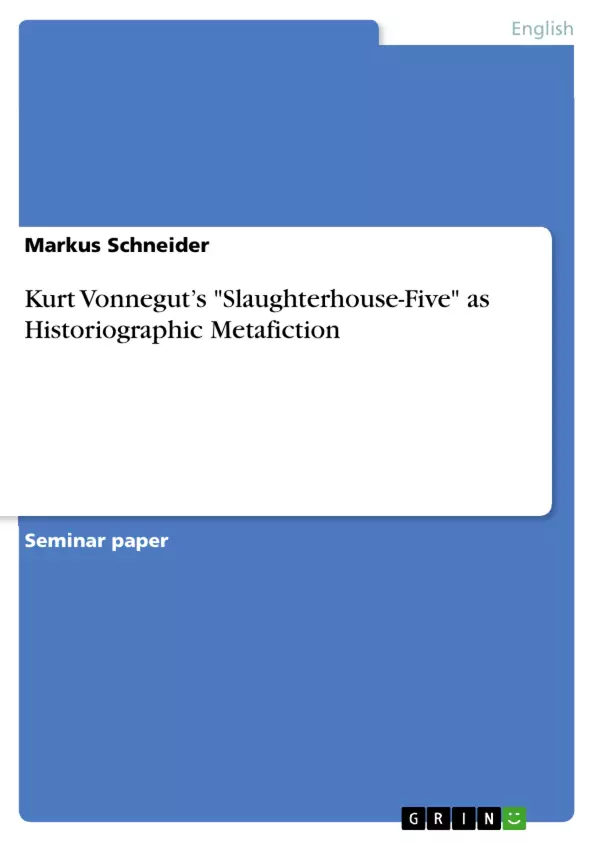The representation of history depends mainly on the perspective, attitude and
cultural background of the beholder; which at the same time marks the major flaw of
historiography. One topic or event will never be identically described by two historians,
even if they are given the very same materials and sources to work with. As a consequence,
historiography can only try to create an image, as true and original as possible, but is never
able to depict everything that happened as it actually was in its full scope. So there were
and always will be fictional elements and interpretations in the reports and writings about
past events.
This assumption leads us to historiographic metafiction, a style of writing that
emerged during the postmodern era. If there is fiction in scholarly historiography, where is
the difference between that and a novel that deals with history? This term paper will try to
give an answer to that question and examine features and characteristics of historiographic
metafiction, which eventually will be applied to Kurt Vonnegut’s Slaughterhouse-Five. In
postmodern literature and, of course, especially in historiographic metafiction, authors
tried to find new ways of telling stories and particularly representing history. I will take a
closer look at the narrative frame and especially the concept of time Vonnegut used in the
novel. But how is history represented in Slaughterhouse-Five? This will be the second part
of the analysis that will attempt to find answers why Vonnegut wrote the novel the way he
did. The third part will deal with intertextual elements in the novel. All citations from the
novel and the pages indicated in brackets are taken from the edition cited below.
Table of Contents
- I. Introduction
- II. Kurt Vonnegut's Slaughterhouse-Five as Historiographic Metafiction
- 1. Historiographic Metafiction
- 2. Historiographic Metafictional Elements in Slaughterhouse-Five
- 2.1 Time
- 2.2 History
- 2.3 Intertextuality
- III. Conclusion
- IV. Bibliography
Objectives and Key Themes
This paper aims to analyze the characteristics of historiographic metafiction and apply them to Kurt Vonnegut's novel "Slaughterhouse-Five." The paper will explore the ways in which Vonnegut uses literary techniques to represent history and challenge traditional notions of time and narrative structure.
- The concept of historiographic metafiction and its blurring of boundaries between fiction and history.
- The representation of time in "Slaughterhouse-Five" and its significance in the context of historiographic metafiction.
- The portrayal of history in "Slaughterhouse-Five" and its relationship to the novel's metafictional elements.
- The role of intertextuality in "Slaughterhouse-Five" and its contribution to the novel's understanding of history.
Chapter Summaries
The Introduction provides a general overview of historiography and its limitations, leading to the emergence of historiographic metafiction in the postmodern era. This section also introduces the focus of the paper, which is to analyze Kurt Vonnegut's "Slaughterhouse-Five" through the lens of historiographic metafiction.
Chapter II delves into the concept of historiographic metafiction, defining it as a style of writing that combines fictional elements with historical events. The chapter explores the historical context of this genre, including the "postmodern crisis of representation" and the rejection of objective truth in history. It also discusses the role of interpretation and the blurring of lines between historical fact and fictional creation.
Chapter II.1 focuses on the representation of time in "Slaughterhouse-Five." It analyzes the novel's non-linear structure and explores the different time zones experienced by the protagonist, Billy Pilgrim. The chapter also examines the significance of these time jumps in relation to the novel's themes of war, trauma, and the human condition.
Chapter II.2 explores the novel's depiction of history, examining how Vonnegut uses historical events as a backdrop for exploring larger themes of the human experience. This chapter investigates the ways in which the novel challenges traditional historical narratives and explores the impact of war on individuals and societies.
Chapter II.3 delves into the role of intertextuality in "Slaughterhouse-Five," analyzing the novel's references to other literary works, historical events, and cultural contexts. The chapter examines how these intertextual elements contribute to the novel's overall message about the nature of history and its relationship to fiction.
Keywords
The key terms and concepts explored in this paper include historiographic metafiction, postmodernism, representation, time, history, intertextuality, Kurt Vonnegut, "Slaughterhouse-Five," and the postmodern crisis of representation.
- Arbeit zitieren
- Markus Schneider (Autor:in), 2008, Kurt Vonnegut’s "Slaughterhouse-Five" as Historiographic Metafiction, München, GRIN Verlag, https://www.grin.com/document/117815



